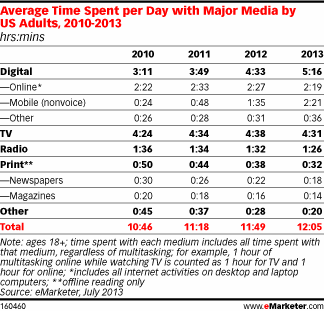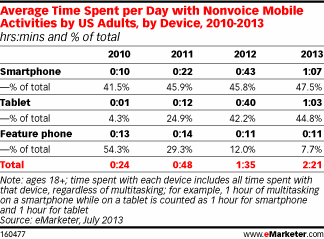Mobile video consumption is reaching levels that will conceivably enable new businesses, recast several industries and likely accelerate change within the video ecosystem. Netflix and YouTube might be clear winners. Leading mobile service providers could be big winners. Smaller programming networks could be winners.
Prospects are less obviously helpful for fixed network service providers unable to provide a mobile consumption option, local TV broadcasters or some larger programming networks.
There is a growing reason why mobile service providers and likely traditional TV subscription providers are looking at mobile delivery: that is where consumption is growing fastest, and where perhaps half of all video gets consumed in the U.S. market.
You would be hard pressed to figure out whether changing consumer demand or different supply modes drive revenue changes in the video entertainment market, though it takes a mix of both.
For the first time ever, customers of Verizon’s FiOS TV service are being allowed to watch live television on their mobile devices when they’re out of their homes, and disconnected from their home’s Wi-Fi network. That’s a big step, but just a step, as the new feature applies to just nine channels, including BBC America, BBC World News, EPIX, NFL Network (iPad-only), HGTV, DIY, the Tennis Channel and Scripps Networks Interactive channels, Food Network and Travel Channel.
As often is the case, smaller competitors have taken the lead, not the biggest networks. Just how much pressure for change will now be exerted is the question.
The other question is how much of a boost the new Verizon feature, and others that assuredly will eventually follow, will increase the importance of mobile video as a revenue stream for mobile service providers.
AT&T, for example, plans to launch a TV delivery service using some Long Term Evolution spectrum. It seems unlikely AT&T will launch a “standard” subscription video service, as it has limited spectrum.
Some suspect AT&T will want to provide localized broadcasting of events, or other information services (weather, news, alerts) of broad interest in a local market. Think of that application as making AT&T something of a local over the air TV broadcaster.
That isn’t to say fixed network providers without mobile assets have no options. Verizon is allied with major U.S. cable operators in agency agreements that allow each to sell the other firm’s products.
But there still are gross revenue and profit margin implications, as simply acting as a sales agent does not provide the gross revenue or profit margin of a service sold on an “owned” basis.
So video subscription providers will want to move with their audiences, delivering the same content on mobile and tablet devices, out of home or in home, as they now do inside the home. That’s the whole idea behind TV Everywhere efforts.
 Whether that represents a “new” market, or simply a new way to support an older market, is a matter of debate, in some ways. In some cases, it is both. You might argue that Netflix and other streaming services are a “new” business, while out of home streaming offered by cable, satellite and telco TV services is an extension of an existing business.
Whether that represents a “new” market, or simply a new way to support an older market, is a matter of debate, in some ways. In some cases, it is both. You might argue that Netflix and other streaming services are a “new” business, while out of home streaming offered by cable, satellite and telco TV services is an extension of an existing business.
In any event, 2013 probably will be the first year ever in the United States that video consumption on devices other than televisions surpasses traditional TV viewing. That’s the demand side of the equation, but that consumption pattern also is enabled by availability of Netflix and YouTube, among other suppliers.
The most significant growth area is on mobile. U.S. adults will in 2013 spend an average of two hours and 21 minutes per day on non-voice mobile activities.
That includes mobile Internet usage on phones and tablet, while mobile device is up nearly an hour from 2012 levels.
The report says that adults are watching their televisions slightly less—with a daily intake of four hours and 31 minutes this year, seven minutes less than in 2012.
The typical U.S. adult will spend over five hours per day online, on non-voice mobile activities or with other digital media, compared to four hours and 31 minutes watching television.
Daily TV time will actually be down slightly in 2013, while digital media consumption will be up 15.8 percent.
 Measurement, in an era where people frequently multitask, is a key issue. Estimates by eMarketer include all time spent within each medium, regardless of multitasking.
Measurement, in an era where people frequently multitask, is a key issue. Estimates by eMarketer include all time spent within each medium, regardless of multitasking.
Consumers who spend an hour watching TV while multitasking on tablet devices, for example, are counted as spending an hour with TV and an additional hour on mobile.
Such multitasking also drives an increase in the overall time people spend with media each day, which eMarketer expects to rise from 11 hours and 49 minutes in 2012 to 12 hours and 05 minutes in 2013.
The key finding is that time spent with mobile has come to represent a little more than half of TV’s share of total media consumption.
